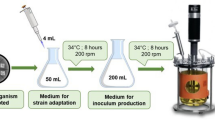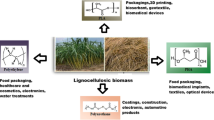Abstract
Most lignin research has been on wood-rot fungi and not on other lignolytic organisms. Members of the genusAspergillus inhabit lignin-rich environments, and we have studied their relative lignin-degrading potential.Aspergillus fumigatus, A. japonicus, A. niger, andA. terreus were tested for their ability to metabolize14C-labeled aromatic compounds. The species tested decarboxylated, demethoxylated, and cleaved the rings of coumaric, ferulic, vanillic, veratric, and anisic acids. More than 90% of C-ring-labeled ferulic and vanillic acids disappeared from the medium in 96 h of cultivation. More than half of the above was respired, the rest was incorporated in unknown form into the mycelium. Mycelia were homogenized and about 3% of the initial label was found in TCA precipitate of the cell-free supernatant. Protocatechuic acid 3,4-dioxygenase (EC 1.13.11.3) and catechol 1,2-dioxygenase (EC 1.13.11.1) activities were detected in the mycelial extracts of theAspergillus spp.
All theAspergillus spp. were capable of degrading both aromatic and carbohydrate components of water-soluble lignocarbohydrate complexes (LCC) from wheat straw. The degradation of the aromatic moiety of soluble LCC with apparent molecular mass more than 100,000 daltons was far more active in theAspergillus spp. than in the whiterot fungi tested; i.e.Polyporus versicolor, Pleurotus ostreatus, andForties annosus. The aromatics present in the soluble LCC, as well as a variety of lignin-related compounds tested, did not affect the production of hemicellulases byA. japonicus.
Aspergillus spp. degraded14C-dehydrogenative polymerizates, converting carbon from the ring as well as from the -O14CH3 groups to14CCO2.14CO2 release after 21 d did not exceed 10% of the total14C input. This situation is comparable to some white-rot fungi. Lignosulfonate was poorly degraded byA. japonicus, but clearly modified.Fomes annosus was able to grow much better on lignosulfonate whenA. japonicus had previously grown on it.Aspergillus spp. grew efficiently on wheat straw, utilizing lignin and some carbohydrates, and rendering the remaining carbohydrates more available to attack of carbohydrases.
Similar content being viewed by others
Author information
Authors and Affiliations
Rights and permissions
About this article
Cite this article
Milstein, O.A., Haars, A., Sharma, A. et al. Lignin degrading ability of selected aspergillus Spp.. Appl Biochem Biotechnol 9, 393–394 (1984). https://doi.org/10.1007/BF02798992
Issue Date:
DOI: https://doi.org/10.1007/BF02798992




